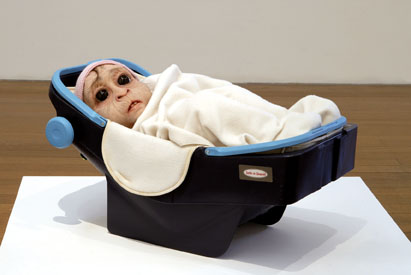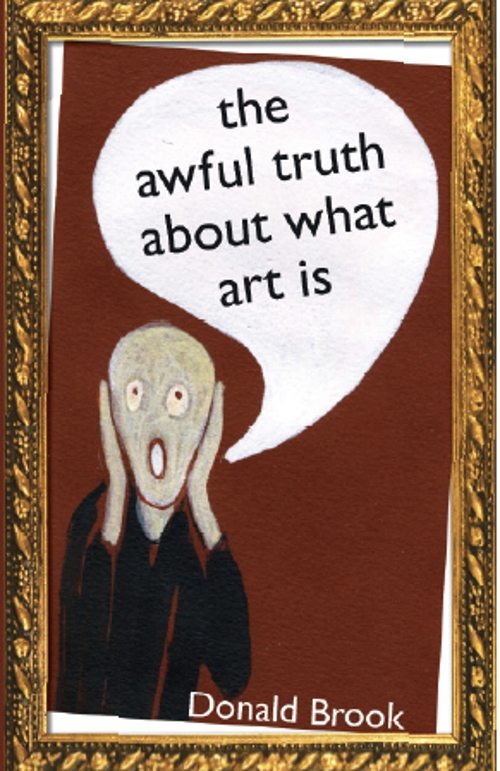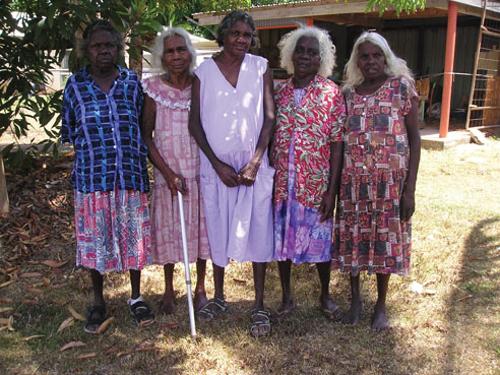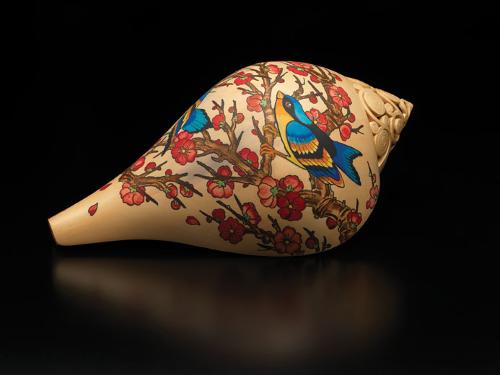
A little boy with short, brown hair wearing riding boots, corduroy trousers and a long sleeved blue/grey top sits on a bench, his feet barely touching the ground. The boy is asleep; his head rests on his companion, an oversized naked creature cradled in his little arms. The creature, asleep, head resting on the boy's lap, is elderly; its strands of hair are long, wispy and grey, deep wrinkles crease its face and body, its pores are clogged and its sallow skin sags. The creature appears as a cross between a mermaid-like, alien animal with a hairy mane leading to a long tail that ends in a webbed foot and unkempt toenails, and an artificial human, with primate-like cranial features, breasts with nipples, arms and a belly-button. It is amazingly life-like and the detail is incredible; one would swear that the creature is slowly breathing. What we are witnessing here is a private, intimate moment between a boy and a hyper-real creature, where difference has given way to tenderness, companionship and a sense of belonging. This silicon and fibreglass sculpture, titled 'The Long Awaited' (2008), is one of the many highlights of Patricia Piccinini's recent absorbing solo exhibition entitled Related Individuals.
Piccinini, who lives and works in Melbourne, is known both in Australia and internationally for her critique of what is natural and artificial in the current world of digital and technological phenomena, as seen in previous installations such as 'Truck Babies' and 'We Are Family' which was exhibited in the Australian pavilion at the 2003 Venice Biennale. Her sculpture, photography, video and installations interrogate world issues such as biogenetics and cloning, bioethics, consumer culture, artifice and nature, in particular how these ideas are subtly changing our society. Piccinini has an uncanny way of anthropomorphising inanimate materials and objects into surreal, life-like creatures and genetically modified beings that subvert our perception of what is possible in this world. In describing her practice, she states: 'I am interested in the way that contemporary biotechnology and even philosophy erode the traditional boundaries between the artificial and the natural, as well as between species and even the basic distinctions between animal and human.'
Related Individuals continues this artistic pursuit with a new freshness and vigour. Gone are any photographic works, and instead the viewer is left with 'not quite animal' bronze skulls, three standout silicon and fibreglass sculptures and a short, poignant video. The bronze pieces are an extension and continuation of Piccinini's interest in the permeability of various boundaries in the contemporary world. 'Not Quite Animal' ('Transgenic Skull for The Young Family') (2008) provides an alternative to Piccinini's fleshy silicon sculptures. Here, she has created an anatomically accurate cranial form, an internal skeleton structure that teeters on the precipice of being human and being animal, and so what is uncanny is also unbelievably familiar in a completely natural manner. The skull in itself is also loaded with meaning and history, life and death, mortality and the transience of life as well as religion, gothic cultures and the occult.
The 'Foundling' (2008), a baby made out of silicon and human hair, lies off to the side of the main gallery space. The abandoned child is nestled underneath a baby blanket inside a well-worn bassinet; its legs appear cramped and bent in order to fit. The foundling's head is covered by a woollen knitted beanie to keep it warm, and tufts of thin brown hair protrude outwards. The foundling's vulnerable eyes are larger than life, disproportionate to its face, and they stare up at the viewer pleading for attention and begging to be nurtured. The creature's facial features are strange and yet familiar; ears, nose and mouth are distorted and elongated. The creature is somewhat tragic – a newborn baby that appears drastically aged, tired and wrinkled. One wonders how long it has been left in its bassinet.
The video on display in the adjacent second gallery space, titled 'The Gathering' (2007), conveys the story, set in a residential home on a suburban street, of several furry organisms encroaching around a sleeping girl, who is lying on the floor of a bedroom, wearing a pink and purple tracksuit and little sneakers. The organisms have reddish/ pink orifices that open and reveal amoebic-like forms inside – a distinct contrast to the serene placidity of the girl quietly sleeping. The soundtrack to this video is clever; transcendental beats lull the viewer into a soporific state, and mimic the rhythmic movements of the species bopping along the floor toward the girl. Just as in 'The Long Awaited', the human girl and the alien-like blobs seem perfectly at ease with one another. Piccinini's point is suitably reinforced – we are all related individuals.












